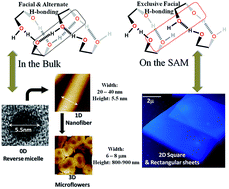Tailoring strained oxanorbornane headgroups to dimensionally controlled nanostructures through hydrogen bonding†
Abstract
An amphiphilic oxanorbornane skeletal frame has been efficiently organized to direct the formation of dimensionally controllable, geometry-specific nanostructures as diverse as 0-D surface/reverse micelles, 1-D nanofibers, 2-D rectangular/square sheets, and 3-D flowers. The racemate with its precise stereo-projection of the –OH groups and the ring oxygen could be used for Li+ ion sensing and aided in the formation of pre-micellar aggregates of conventional surfactants.


 Please wait while we load your content...
Please wait while we load your content...